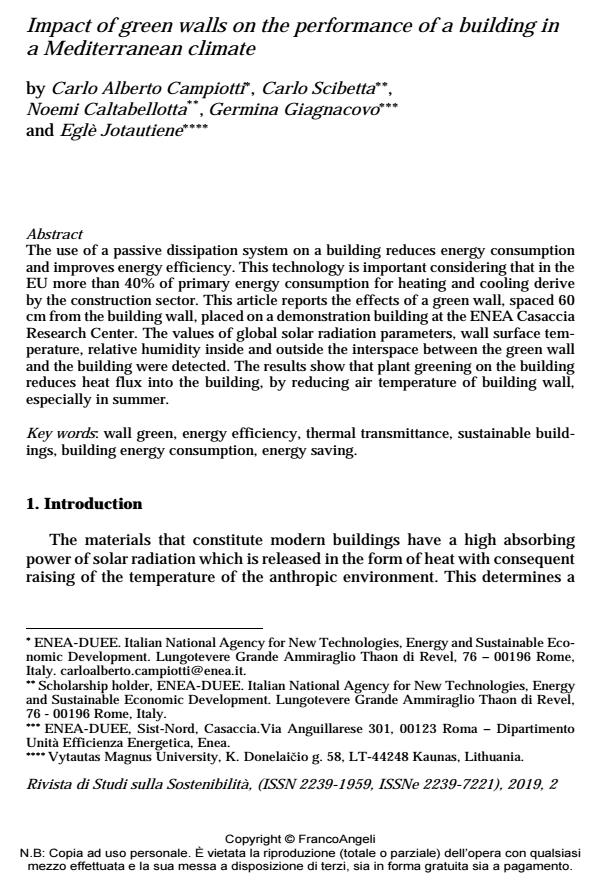Impact of green walls on the performance of a building in a Mediterranean climate
Titolo Rivista RIVISTA DI STUDI SULLA SOSTENIBILITA'
Autori/Curatori Carlo Alberto Campiotti, Carlo Scibetta, Noemi Caltabellotta, Germina Giagnacovo, Eglè Jotautiene
Anno di pubblicazione 2020 Fascicolo 2019/2 Suppl.
Lingua Inglese Numero pagine 18 P. 9-26 Dimensione file 519 KB
DOI 10.3280/RISS2019-002-S1002
Il DOI è il codice a barre della proprietà intellettuale: per saperne di più
clicca qui
Qui sotto puoi vedere in anteprima la prima pagina di questo articolo.
Se questo articolo ti interessa, lo puoi acquistare (e scaricare in formato pdf) seguendo le facili indicazioni per acquistare il download credit. Acquista Download Credits per scaricare questo Articolo in formato PDF

FrancoAngeli è membro della Publishers International Linking Association, Inc (PILA)associazione indipendente e non profit per facilitare (attraverso i servizi tecnologici implementati da CrossRef.org) l’accesso degli studiosi ai contenuti digitali nelle pubblicazioni professionali e scientifiche
The use of a passive dissipation system on a building reduces energy consumption and improves energy efficiency. This technology is important considering that in the EU more than 40% of primary energy consumption for heating and cooling derive by the construction sector. This article reports the effects of a green wall, spaced 60 cm from the building wall, placed on a demonstration building at the ENEA Casaccia Research Center. The values of global solar radiation parameters, wall surface temperature, relative humidity inside and outside the interspace between the green wall and the building were detected. The results show that plant greening on the building reduces heat flux into the building, by reducing air temperature of building wall, especially in summer.
Parole chiave:Wall green, energy efficiency, thermal transmittance, sustainable buildings, building energy consumption, energy saving.
- Bibbiani C., Campiotti C.A., Giagnacovo G., Incrocci L., Pardossi A., Latini A. and Schettini E. (2018). Green roofs and green façades for improving sustainability of towns. Acta Hortic., 1215. ISHS.
- Campiotti C.A., Caltabellotta N., Campiotti A. and Scibetta C. (2019). Green Walls for improving energy efficiency of buildings. Calitatea, 20(S2): 157-161.
- Campiotti C.A., Consorti L., Giagnacovo G., Nencini L. and Scoccianti M. (2018). Le coltri vegetali nel settore residenziale. Energia, ambiente e innovazione.
- Campiotti C.A., Schettini E., Bibbiani C., Alonzo G. and Viola C. (2013). Building green covering for a sustainable use of energy. Journal of Agricultural Engineering, 44(2s).
- Fernandez-Cañero R., Emilsson, T., Fernandez-Barba C. and Herrera Machuca M.A.
- (2013). Green roof systems: A study of public attitudes and preferences in southern Spain. Journal of Environmental Management, 128: 106-115.
- Rowe D.B. (2011). Green roofs as a means of pollution abatement. Environmental Pollution, 159: 2100-2110.
- Schettini E., Campiotti C.A., Scarascia Mugnozza G., Blanco I., and Vox G. (2018). Green walls for building microclimate control. Acta Hortic., 1215. ISHS.
- Vox G., Blanco I., Fuina S., Campiotti C.A., Scarascia Mugnozza G. and Schettini E. (2017). Evaluation of wall surface temperatures in green facades. Proceedings of the Institution of Civil Engineers. Engineering Sustainability.
- Study on the dynamic heat transfer role of vertical greening in building microclimate based on multi-objective coupling Liang Qiao, in Journal of Renewable and Sustainable Energy 025101/2025
DOI: 10.1063/5.0240874
Carlo Alberto Campiotti, Carlo Scibetta, Noemi Caltabellotta, Germina Giagnacovo, Eglè Jotautiene, Impact of green walls on the performance of a building in a Mediterranean climate in "RIVISTA DI STUDI SULLA SOSTENIBILITA'" 2 Suppl./2019, pp 9-26, DOI: 10.3280/RISS2019-002-S1002